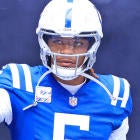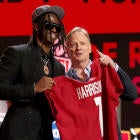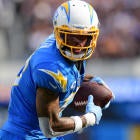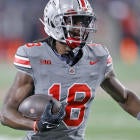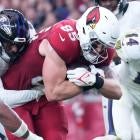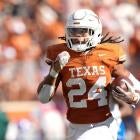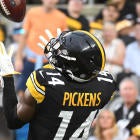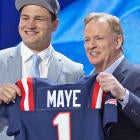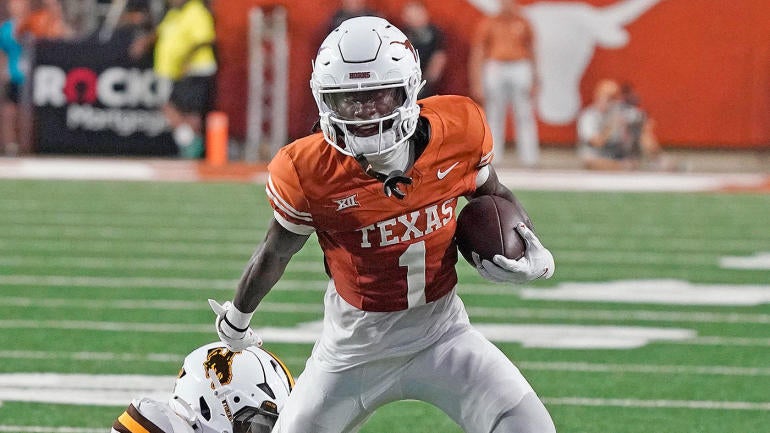
The Kansas City Chiefs traded up from No. 32 to 28 to secure Texas WR Xavier Worthy. The fastest 40-yard dash in the history of the NFL Combine belongs to Worthy, who is the complete package athletically. His 41-inch vertical jump ranked 97th percentile, his broad jump ranked 90th percentile, and his 10- and 20-yard splits dusted even the likes of Tyreek Hill and DeSean Jackson.
Unlike former teammate Adonai Mitchell, Worthy does not bring athleticism without production attached to it. He also boasts a 96th percentile breakout age, as Worthy's first season with the Longhorns resulted in 981 yards and 12 touchdowns through the air.
Xavier Worthy as a true freshman at a Power 5 program:
— Jacob Gibbs (@jagibbs_23) April 26, 2024
- 32% target share
- 36% receiving yardage share
- 41% receiving TD share
Those are ABSURD rates.
So, are comparisons to former Kansas City swings-and-misses on speedsters fair? Statistically, absolutely not. Worthy produced more receiving yards and touchdowns as a true freshman than Mecole Hardman did in his Georgia career. Kadarius Toney produced 1,590 receiving yards and 12 touchdowns in his four-year career at Florida, Worthy's career totals are 2,755 and 26 across just three seasons.
Is Worthy's production profile perfect? It's not, there are some question marks that I have after digging into his data. His efficiency only got worse after his freshman year, that's weird. From an efficiency standpoint, one could make a case that both Hardman and Toney were better than Worthy in college. In fact, most NFL Draft WR prospects likely were more efficient on a per-target and per-route basis than Worthy was at Texas. What's that all about?
I wrote about Worthy, AD Mitchell, and the rest of the incoming rookie WR class in detail for SportsLine. If you are curious, you can learn more about the contextual data that I found by following this article link. In Worthy's case, one key to understanding his lackluster efficiency comes in the form of his inflated off-target rates.
Highest career off-target rates from the WR prospects I evaluated:
— Jacob Gibbs (@jagibbs_23) April 4, 2024
(per @TruMediaSports)
22.4% — Xavier Worthy
17.9% — Devontez Walker
17.6% — Ricky Pearsall
17.2% — Ainias Smith
16.8% — Keon Coleman
16.8% — Jermaine Burton
16.1% — Adonai Mitchell
Worthy's rate stands isolated at the top with a wide gap before any other player, and that gap is only widened the deeper the target threshold becomes. On targets of 20+ air yards, Worthy's off-target rate was 42%! No other WR prospect from the 2024 class had a rate above 30%!
While Patrick Mahomes has not been as effective on downfield throws since the Chiefs traded away Tyreek Hill, it goes without saying that he'll be an improvement over what Worthy has contended with over the past few seasons. For what it's worth, among 37 quarterbacks with 50+ deep attempts (20+ air yards) over the past two seasons, Mahomes has the 12th-lowest off-target rate. He's remained above average in this regard, and that has been with few receivers capable of providing open targets down the field.
More than just a deep threat?
Worthy may be more than just a downfield burner. At Texas, Worthy produced 8.5 yards after the catch per reception on catches that came 10 or fewer yards from the line of scrimmage. For reference, the average among receivers selected in Round 1 or 2 over the past 10 years is 6.7 yards. Worthy's rate was identical to Deebo Samuel's and just ahead of the likes of Zay Flowers, Rondale Moore, Wan'Dale Robinson, and Rashee Rice.
Getting Worthy "lay-up" looks where he can catch the ball in space and create easy yardage will be key to any potential 2024 Fantasy relevancy.
Worthy's fit in Kansas City's offense
What type of role is ideal for Worthy's skillset as he adapts to the NFL game? For this question, I'll defer to the incredible work of Matt Harmon. Matt is the creator of Reception Perception, a proprietary wide receiver evaluation tool that isolates the work that a wide receiver is putting in, independent of outside factors such as coaching or QB play. Specifically, he's focused on a receiver's route tree and success vs. varying coverage types.
I highly encourage digging into all of Matt's work on ReceptionPerception.com. For the purposes of today's discussion, here's what I found most pertinent from Worthy's Reception Perception profile:
"I'd categorize Worthy as a solid separator overall. Speed isn't everything. I'd like to see a little more nuance in his route running. Right now his toolbag is a little light as he tries to win with speed first and when a route requires a bit of extra craft to shake free, he finds himself tangled up.
That said, I don't want to categorize him negatively as a separator. He displays far more "real receiver" game than some of the failed speed merchants of days gone by.
Worthy's speed does show up when running straight go routes down the field. He can get tangled in man coverage in the intermediate portion of a nine but if he gets by in those early stages and on top of a corner, he's winning that battle more often than the average collegiate receiver. His 73.7% success rate on post routes was notable considering the volume at which he ran the route. He can really split defenses right in half against zone coverage and drive a crushing play through the spine. It's easy to imagine him as a devastating option in a speed slot role winning on post routes.
Worthy also shows flashes of what I need to see out of a speed receiver to fully maximize their potential. I want to see a receiver who should be feared for his speed be able to take advantage of corners when pushing vertical before snapping back on curls or toward the sideline on out routes. Worthy is better at the latter, especially against zone, but I need to see just a bit more consistent use of deception when working back to the quarterback. We are close, there's just a bit more work needed.
Worthy is a generally good separator when he has a free release at all areas of the field. He can win intermediate complex routes, dominate on straight-forward vertical plays and uncover underneath. More pressing (no pun intended) issues arise when any sort of contact is involved."
Matt's RP data aligns with what I found on TruMedia (the database that I use) -- Worthy was more efficient (relative to expectation) against zone coverage than man, and he struggled vs. press coverage. Ideally, the Chiefs will get him involved as the pre-snap motion man and part-time slot receiver to create more free releases and avoid press coverage. Kansas City ranked fourth in pre-snap motion behind only the Dolphins, 49ers, and Rams in 2023. And while Rice profiles as a slot-dominant player, he may miss games with a suspension in 2024.
I expected Kansas City to target a receiver with more size who fits the "true X-receiver" mold, allowing them to move Rice and Hollywood Brown around as the primary slot and flanker options. It will be interesting to see how these receivers align given some of the redundancies in size and skillsets. Kansas City's move up to pick 28 suggests that there is a plan in place for Worthy's role, and no offense has produced more Fantasy points over the past two seasons than this Mahomes-led unit.
There's massive long-term Fantasy upside available to him even if his immediate role isn't clear yet. Worthy's collegiate data indicates that he is more than just a deep threat and is capable of demanding Fantasy-relevant target volume, so I'm extremely intrigued for Fantasy purposes now that we have Round 1 draft capital investment confirming his talent. The bottom of his ranges of outcomes is something similar to what we've seen from Hardman and Toney in Kansas City, while the top is a special type of player like DeSean Jackson.
Thinking about his former players, Andy Reid likens Xavier Worthy to DeSean Jackson more so than a Tyreek Hill.
— Pete Sweeney (@pgsween) April 26, 2024
In my opinion, Rome Odunze, Marvin Harrison Jr., Malik Nabers, and Brock Bowers are the only rookies who carry a higher Dynasty value than Worthy at this point. I've moved Worthy ahead of Brian Thomas Jr. in my rankings for both Dynasty and 2024 season-long drafting purposes, and it would not surprise me at all if he outproduced Odunze in Year 1. Defenses won't be able to key on any one player in Kansas City's offense and will be all but forced to rely on two-high safety coverages to contend with the speed threat. Worthy's collegiate career suggests that he should feast against these types of coverages.













